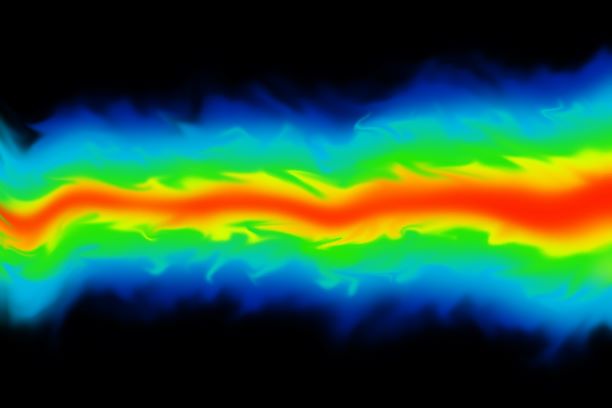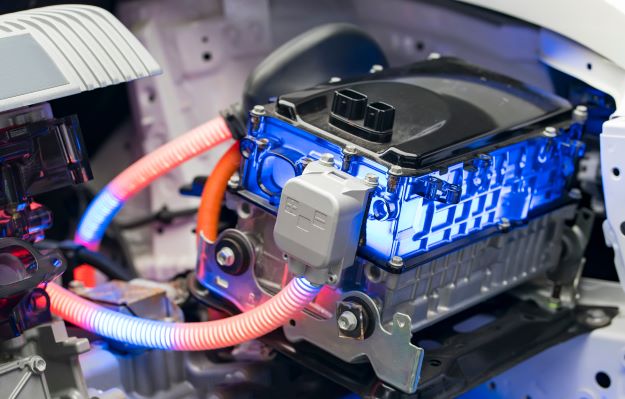Courses by Software
Courses by Semester
Courses by Domain
Tool-focused Courses
Machine learning
POPULAR COURSES
Success Stories
simulation of Rayleigh Taylor Instability using ansys
Introduction In this Rayleigh – Taylor instability simulation the lighter fluids are above the lighter fluid and regime is accelerated by gravity. Also, phase between two fluids is marked H(x)/patch by 1 for heavier fluid and zero for lighter fluid. Rayleigh–Taylor instability…
saurabh talele
updated on 28 May 2020
Introduction
In this Rayleigh – Taylor instability simulation the lighter fluids are above the lighter fluid and regime is accelerated by gravity. Also, phase between two fluids is marked H(x)/patch by 1 for heavier fluid and zero for lighter fluid.
Rayleigh–Taylor instability [RTI]
Two fluids of different densities superposed one over the other (or accelerated towards each other); the instability of the plane interface between the two fluids, when it occurs, is called the Rayleigh-Taylor instability”.
The Rayleigh–Taylor instability (RTI) is a fundamental instability of an interface between two fluids of different densities, which occurs when a heavy fluid is superposed over a light fluid in a gravitational field or when a hydrodynamic instability occurs in any accelerating fluid system in which the density and pressure gradients have opposite signs.
Used to an analysis of–
- Include the behaviour of water suspended above oil in the gravity of Earth,
- mushroom clouds like those from volcanic eruptions and atmospheric nuclear explosions,
- supernova explosions in which expanding core gas is accelerated into denser shell gas, Capillarity modelling
- Instabilities in plasma fusion reactors and inertial confinement fusion.
- Used to research on fuel atomization, fuel spray from nozzle modelling in IC engine, marine simulation
- Used to forecast rain, to predict the effect of cirrus clouds
- Spray drying, industrial painting, environmentally friendly combustion, inkjet printing, materials processing, fire suppression, and pharmaceutical coating, Geo-fluid dynamics, oil extraction plat which on surface or in sea
- Used in simulate boiling and condensation (design of heat exchangers), cavitation in gas engine, granular flows and wherever bubble and wall interaction happening, Electro-hydrodynamics,cavity filling in casting, turbulent mixing of chemicals, Porous flow modelling like water purifying plants to simulate osmosis process, Bubble breakup and wall or heated wall interaction modelling, Modeling of airplane in raining or in thunderstorm,air bubble formation in the blood of deep-sea diver,
- Used also in ; Liquid atomization such as agriculture, coatings, gasification, water scrubber, pharmaceuticals, metal powder production, 3D printing, spray drying, fire suppression, and cooling.
Below image shows that transient simulation of heavier fluid is over lighter fluids and gravity is on –ve Y Direction.

Practical CFD models that have been based on the mathematical analysis of Rayleigh Taylor waves
Liquid Film Atomization on Wall Edges—Separation Criterion and Droplets Formation Model [4]
Used to predict fuel mixture preparation inside port fuel injection engine. In model for the aerodynamic stripping of the fuel film deposited on the manifold walls is discussed, and a model for the fuel film separation and atomization near the sharp edges is developed.
Direct contact condensation modeling in pressure suppression pool system [5]
In this simulation Chugging condensation mode in drywell–wet well suppression pool system is simulated they have used Eulerian two phase compression wave solver used along with Raleigh Taylor instability in consideration and that is why this model gives appropriate results; which they have validated, using capture bubble volume data from cameras.
Two-Phase Flow Simulation with Lattice Boltzmann Method: Application to Wave Breaking [6]
To efficiently simulate multiphase flows with high-density ratios, in order to study complex air-sea interaction problems, such as wind wave breaking and related sea-spray generation.
K-L turbulence model for the self-similar growth of the Rayleigh-Taylor [RT] and Richtmyer-Meshkov [RM] instabilities [7]
This type of models used in a multidimensional multiphase flow which are comes under RT and RM flows. Application are in Inertial confinement fusion ; (ICF) is a type of fusion energy research that attempts to initiate nuclear fusion reactions by heating and compressing a fuel target, typically in the form of a pellet that most often contains a mixture of deuterium and tritium [9].
Discrete particle modelling (DPM) of granular Rayleigh–Taylor instability [8]
This method simulates the gravitational air–grain Rayleigh–Taylor (RT) flow instability, Used in to simulate how trapped air is removed through casting sand mould.
CHU model (primary drop breakup)
This model is formulated by Chu which is based on RTI to predict droplet size of fuel based on critical weber number presented in this model for stable radius of a droplet.
Reitz-Diwakar model (primary drop breakup) [10]
This model describes the spray modelling where droplet break ups in bag and stripping breakup [10] which depend upon weber number.
Hear this model comes under; Kelvin–Helmholtz instability (after Lord Kelvin and Hermann von Helmholtz) typically occurs when there is velocity shear in a single continuous fluid, or additionally where there is a velocity difference across the interface between two fluids. A common example is seen with the wind blowing over water, the instability constant is able to manifest itself through waves on a water surface.[13] Also, this model predicts how fluid droplet changes its radius over time.
Kelvin–Helmholtz instability [KH] Rayleigh Tylor [RT] - KHRT model (secondary drop breakup)

Above image shows spray breakup
Below images show RT break up of fluid droplet [14, 15] where ‘a’ is aerodynamic drag and u is velocity vector.

In KHRT model aerodynamic force on fluid flatted that drop into the flat shape of liquid sheet and decelerate it’s into large scale fragments due to RTI. KH wave with much shorter wavelength originates at the edge of fragments and these wave breaks into micrometre size drops.
Below image show, KH wave and RT wave and fluid droplet break up [12,14]

Modelling spray atomization with Kelvin–Helmholtz instability Rayleigh Tylor KHRT hybrid model (secondary drop breakup) [16]
In secondary break up of drop; only the drops beyond the breakup length are affected by RT breakup. Furthermore, a Rosin-Rammler distribution was used to specify the sizes of children drops after the RT breakup of a parent drop. The modifications made to the KH-RT hybrid model were found to give satisfactory results and to improve the temperature dependence of the liquid fuel penetration of the diesel sprays significantly. [16]
Simulation of heavy liquid over lighter liquid that is Rayleigh-Taylor instability
1- Geometry
2- Meshing
3- Setup and solution
4- Post-processing

1- Geometry
2- Meshing
- M1- hex mesh size 0.5 mm
- M2 – hex mesh size 0.4 mm
- M3- hex mesh size 0.2 mm, Number of Elements: 20000
3- Setup
- Setting transient pressure-based solver multiphase implicit simulation is setup
- Fluid is water and air with their default properties from fluent.
- Patching water region as 1 and Air region with 0.
- Fixed time steps,0.005 step size running for 1500 steps
4- Case 1 Solution and postposing of results
- M1- hex mesh size 0.5 mm residual and water fraction contours

- M2 – hex mesh size 0.4 mm residual and water fraction contours

- M3- hex mesh size 0.2 mm residual and water fraction contours

Case 2 Setup o heavier fluid has a density as 400 kg/meter cube and viscosity as 0.01kg/m/s Hexa mesh size of 0.02 mm
- Setting transient pressure-based solver multiphase implicit simulation is setup
- The fluid is user-defined fluid with properties of density as 400 kg/meter cube and kinematic viscosity of 0.01kg/m/s and air with its default properties from fluent.
- Patching water region as 1 and Air region with 0.
- 005 step size running for 1500 steps
M3- density as 400 kg/meter cube and viscosity as 0.01kg/m/s hex mesh size 0.2 mm residual and water fraction contours

Atwood number And transient simulation
h- Heavy fluid
l – Light fluid
Rho – density of a fluid
Case 1 -Atwood number for water 998.2 kg/meter cube and air 1.225 kg/meter cube simulation is 0.9975
Case 2 - Atwood number for user-modified properties density as 400 kg/meter cube and kinematic viscosity of 0.01kg/m/s and air has a density of 1.225 kg/meter cube is 0.9938
- Increase in Atwood number increase in the permutation and generate large length of spikes of heavy fluid in the lighter fluid at the instant of time and also it's can be visualized by above contours case 2 is vortices is for a larger time in lower compartment than case 1 setup.
- Atwood number significance: In Rayleigh–Taylor instability, the penetration distance of heavy fluid bubbles into the lighter fluid is a function of acceleration time scale where g is the gravitational acceleration and t is the time.
Transient simulation
- From the above discussion, RTI is time-dependent phenomena which occurred at the face of two different density fluid, where at the face of two fluids that is lighter fluid and heavy fluid ;
the heavy fluid is accelerated in perceptive to gravity and thus velocity or any other property of fluid can’t become constant with respect to time in the regime and also because of momentum and energy transfer of fluid from one fluid to other; that is why also this type of simulation comes under transient case though maybe it reached equilibrium in above simulation but due to air there will be wave are generated over the face of water when water comes down. [18]
- when the heavy fluid sits on top, the growth of a small perturbation (a deviation of a system) at the interface is exponential and takes place at the rate of
H=exp(A*G*alpha*time^2)
A - Atwood number
G - Gravitational acceleration
Alpha - wavenumber is the number of waves per unit distance.
Time – time
H= amplitude of wave when liner stability theory is valid after some time this theory gets invalid because of the non-linear behaviour of two fluid
So that spikes generated on face two-fluid is a time-dependent phenomenon and that is why also this type of simulation is transient.
- If the heavier fluid compartment is pressurized and lighter fluid is a vacuum then at face after permutation is generated there will be shock waves are generated and in a regime of the shock wave, there is a change in fluid properties and that is not dependent on the time that is why this type of simulation is transient.
And also give good result in supernova type of simulation and external aerodynamics aeroplanes simulation where rainy clouds are formed; though RTI based transient simulation simulates the system and give results nearly same but not exact due chaotic nature of the universe.
- If this type of simulation try to simulate with steady-state solver it will not give downward acceleration to the fluid it may happen water doesn’t get at lower bound because numerically this simulation is steady only
After adding or setting transient; Due to time step phenomena that lighter fluid accelerates above with respect to time and heavier fluid gets at lower compartment with respect to time.
Conclusion
RTI type of simulation are basics of multiphase simulation which is discussed above.
References
1- Rayleigh Taylor_instability https://en.wikipedia.org/wiki/Rayleigh%E2%80%93Taylor_instability
2- Rayleigh-Taylor_instability_and_mixing http://www.scholarpedia.org/article/Rayleigh-Taylor_instability_and_mixing
3- https://www.sciencedirect.com/science/article/pii/S0898122113005166
4- https://asmedigitalcollection.asme.org/fluidsengineering/article-abstract/124/3/565/444324
5- https://www.sciencedirect.com/science/article/pii/S0029549316302977
6- https://asmedigitalcollection.asme.org/OMAE/proceedings-abstract/OMAE2013/55416/V007T08A002/270708
7- https://www.researchgate.net/publication/230885678_Numerical_Simulation_of_Rayleigh-Taylor_Instability_With_Two-Fluid_Model_and_Interface_Sharpening
8- https://www.sciencedirect.com/science/article/abs/pii/S0301932215001822
9- https://en.wikipedia.org/wiki/Inertial_confinement_fusion
10- https://www.researchgate.net/figure/Reitz-Diwakar-break-up-model_fig1_257775042
11- https://www.politesi.polimi.it/bitstream/10589/58942/3/M.Sc._Thesis.pdf
12- https://encrypted-tbn0.gstatic.com/images?q=tbn%3AANd9GcSbYMULh-6ZdlaFRMMjRGdIEvdA-uC1q7xbdSAu58HJvDBEX3yP&usqp=CAU
13- https://en.wikipedia.org/wiki/Kelvin%E2%80%93Helmholtz_instability
14- BAUMGARTEN, C. (1996). “Mixture Formation in Internal Combustion Engines”. ISBN -103-540-30835 -0 Springer-Verlag Berlin Heidelberg New York.
15- https://www.google.com/imgres?imgurl=x-raw-image%3A%2F%2F%2F241d7e23e1c77c7881ebbe92aba988437e65a0b67d0bcfa8d242b64816e3f91b&imgrefurl=http%3A%2F%2Fjafmonline.net%2FJournalArchive%2Fdownload%3Ffile_ID%3D41381%26issue_ID%3D237&tbnid=eHzH4SN-HSSAxM&vet=12ahUKEwjI9r7KitbpAhUUcX0KHQQgALQQMygYegQIARA0..i&docid=m-lwkC9vRRSAAM&w=502&h=234&q=KHRT%20model&hl=en&ved=2ahUKEwjI9r7KitbpAhUUcX0KHQQgALQQMygYegQIARA0
16- MODELING SPRAY ATOMIZATION WITH THE KELVIN-HELMHOLTZ/RAYLEIGH-TAYLOR HYBRID MODEL Jennifer C. Beale
17- Atwood_number https://en.wikipedia.org/wiki/Atwood_number
18- Review of theoretical modelling approaches of Rayleigh–Taylor instabilities and turbulent mixing https://royalsocietypublishing.org/doi/full/10.1098/rsta.2010.0020#d20889331e6090s
Leave a comment
Thanks for choosing to leave a comment. Please keep in mind that all the comments are moderated as per our comment policy, and your email will not be published for privacy reasons. Please leave a personal & meaningful conversation.
Other comments...
Be the first to add a comment
Read more Projects by saurabh talele (28)
Week 10 - Simulating Combustion of Natural Gas.
Combustion and reaction chemistry model Combustion and reaction chemistry model used in an internal combustion engine, gas turbine engine, rocket propulsion, gas flares, steel making, boilers, cement kilns, biomedical applications, fire safety, fuel cell, battery cell modelling, environment safe product…
05 Sep 2021 03:52 PM IST
Week 6 - CHT Analysis on a Graphics card
Video rendering card Video rendering card is responsible for accelerating the rendering of graphics on display. And it continuously takes electric energy and dissipates the heat energy like a hot heat sink. Also if heat dissipation is not managed the rendering processes may fail, reduce time to render or in the worst conditions…
23 Aug 2021 08:51 AM IST
Cyclone Separator Challenge
Aim To simulate anthracite particle-based cyclone separator with varying particle size from one micron to five microns with same particle velocity and inlet air velocity that is flow velocity, Also this particle velocity and flow velocity are varied from one to five with same five microns i.e. uniform particle size,…
31 Aug 2020 12:01 PM IST
simulation of Rayleigh Taylor Instability using ansys
Introduction In this Rayleigh – Taylor instability simulation the lighter fluids are above the lighter fluid and regime is accelerated by gravity. Also, phase between two fluids is marked H(x)/patch by 1 for heavier fluid and zero for lighter fluid. Rayleigh–Taylor instability…
28 May 2020 07:10 PM IST
Related Courses


Skill-Lync offers industry relevant advanced engineering courses for engineering students by partnering with industry experts.
Our Company
4th Floor, BLOCK-B, Velachery - Tambaram Main Rd, Ram Nagar South, Madipakkam, Chennai, Tamil Nadu 600042.
Top Individual Courses
Top PG Programs
Skill-Lync Plus
Trending Blogs
© 2025 Skill-Lync Inc. All Rights Reserved.













